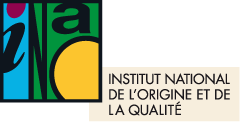INAO, one of the local authorities' partners in protecting the land

Projects for urban planning documents in an appellation d'origine area must be submitted to the INAO for an advisory opinion. For local decision-makers, this approach represents an opportunity to better consider the stakes involved in protecting agricultural areas under SIQO (quality and origin identification sign), but also to arrive at consensual projects that are adapted to the issues of our time.
An important component of regional planning
A public body under the supervision of the Ministry of Agriculture and Food Sovereignty, INAO ensures the recognition and protection of official quality and origin (SIQO) signs: appellation d'origine contrôlée/protégée (AOC/AOP), protected geographical indication (PGI), traditional speciality guaranteed (TSG), organic farming (AB) and Label Rouge.
One of the strong points of geographical indications (GIs: AOC/AOP and IGP) is the definition of a geographical area in which the stages of production, processing and elaboration are carried out, either in their entirety for AOPs or for at least one of them for IGPs. In most AOC/AOP viticoles, there is also a delimited parcel area for grape production.
The INAO is responsible for delimiting but also protecting these natural, agricultural and forest areas, as well as their production potential. 32,000 French communes fall within one or more of these geographical areas. In France, 1.5 million ha are delimited for GI production.
Many local decision-makers are not always aware that the territory they administer falls within the geographical area of a SIQO product, and may underestimate the stakes involved in protecting them. Yet, because of their renown and the quality of the products that benefit from them, GIs are an important component of local development, and contribute to the heritage and economic value of the territory.
Stakes at the heart of the news
According to data published by the Observatoire de l'artificialisation des sols, at least 20,000 hectares of agricultural, natural or forested areas are disappearing every year, equivalent to half the average surface area of a département over the last decade. At a time when priority is given to local food resources, the development of quality agriculture and productive, living rural territories is essential.
The challenges of protecting territories under SIQO are correlated with those of ecological transition. Indeed, preserving agricultural areas contributes to slowing down the artificialization of land; it is fully in line with the objective of achieving "zero net artificialization" (ZAN) of land by 2050. It is also a means of avoiding conflicts of use caused by the extension of urbanized areas close to agricultural zones and of improving local quality of life.
SIQO represent a potential for the development of territories. They enable a qualitative gain in agricultural production, improve producers' incomes and contribute to the maintenance of a local activity specific to the territory and its identity, which, moreover, cannot be relocated. They bring positive externalities, such as preserving the traditional image of landscapes associated with SIQO products, an undeniable tourist argument.
An intervention based on education and consultation
Regulations stipulate that the INAO must be asked for an advisory opinion in the context of urban planning documents (SCoT, PLU communal or intercommunal, carte communale) involving the consumption of space classified as AOC/AOP. This process takes place prior to public inquiries. INAO's expertise thus provides invaluable elements for decision-making.
A strong collaboration, carried out well upstream of projects, enables the emergence of developments adapted to the territory's development challenges, the preservation of local heritage and the perpetuation of SIQO agricultural activity.
The INAO also participates, with a deliberative vote, in departmental commissions for the preservation of natural, agricultural and forest areas (CDPENAF), whenever a reduction in SIQO production potential is envisaged, as well as in land development commissions (at departmental and communal levels).
